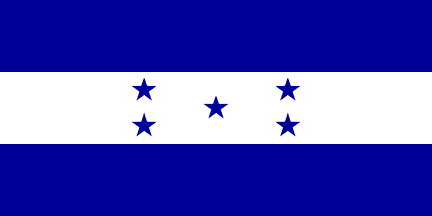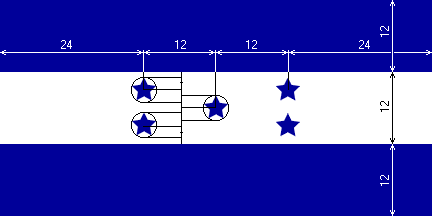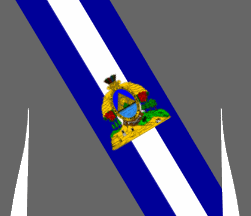![[Flag of Honduras]](../images/h/hn.gif)
Flag according to Clay Moss report
image by Željko Heimer, 1 November 2001

Last modified: 2014-09-13 by zoltán horváth
Keywords: honduras | america | central america | united states of central america |
Links: FOTW homepage |
search |
disclaimer and copyright |
write us |
mirrors
![[Flag of Honduras]](../images/h/hn.gif)
Flag according to Clay Moss report
image by Željko Heimer, 1 November 2001

Flag according to Album 2000 [pay00]
image by Željko Heimer, 1 November 2001
Official Name: Republic of Honduras
(Republica de Honduras)
Capital: Tegucigalpa
Location: Central America
Government Type: Democratic Constitutional
Republic
Flag adopted: 9
January 1866
Coat of Arms adopted: 3 October 1825
ISO Code: HN
See also :
In Carlo A. Ferro's book: The Argentine flag, inspirer of
the central american banners, Honduras choses the same
international naming for white, but curiously not for blue, which
is defined as "turquí" (turquoise?), i.e., dark blue.
Gus Tracchia, 27 November 2000
While visiting Honduras I did not saw a Honduran flag anywhere
that looks like and illustration floating around on a flag chart
or in an encyclopedia. All Honduran flags are proportioned
1 to 2. The constellation of 5 stars on Honduran flags is
spread out much further than what illustrations show.
Starting from the hoist, the first 2 stars are placed at a point
1/3 the length of the flag. The middle star is placed in
the center, and the last 2 stars are placed at a point 2/3 the
length of the flag from the hoist. Also, the stars, though
5 pointed are not the American variety. Each point is wider
at the center. Here is an illustration.
Clay Moss, 5 July 2001
According to Album 2000 [pay00]
- National Flag (CSW/CS- 1:2) - Horizontal trband of
blue-white-blue with five blue stars in the middle stripe. Clay
Moss is stating that all (most?) the flag is Honduras itself use
"fat" stars, and he further gives the construction
details, that I interpret. The Album gives similar image, but
with more traditional stars.
Željko Heimer, 1 November 2001
The image shown in the Album 2000 is correct according to
Figures 4 and 5 of a Decree dated 18 January 1949 (reproduced in
the Folleto Civico of 15 September 1965). This shows that
the stars are set within an imaginary rectangle one-third of flag
length, and that they are conventionally shaped (as in the US
flag). There is no size given for the stars, but from
Figures 4 & 5 I have calculated them to be contained within
an imaginary circle of diameter = 1/18 of flag width.
Incidentally, the flag with stars set closer together (as in the
Flaggenbuch) is based on accuardo no. 194 of 27 September 1933,
and it was originally established by Law No. 7 of the National
Congress dated 19 January 1866.
The colour 'azul turquesa' or 'azul turqui' was defined by an
amendment published in the Folleto Civico of the same date.
Based upon a copy of the Folleto Civico supplied by Armand du
Payrat, and upon information by Ralf Stelter copied from the Flag
Institute files.
Christopher Southworth, 2 March 2003
Fred Drews reported: "I was recently in Honduras.The
Honduras flag definitly has the stars spread out we have
them". The spread-out stars date from a regulation of 1949.
Christopher Southworth, 7 October 2004
From Flags of the World (Talocci 1982):
Honduras achieved independence in 1821 as part of the Central
American federation along with El Salvador, Costa Rica,
Nicaragua, and Guatemala. The present flag, which was officially
adopted in 1949, is similar to that of the federation, which came
to an end in the years 1838 to 1839.
The blue bands stand for the Caribbean Sea and the Pacific Ocean.
The five stars, introduced in 1866, reflect the hope that the
five states may once again form an association...
From Collins Gem Flags (Shaw 1994):
Honduras was one of the five member states of the United
Provinces of Central America and, like other constituent states,
has retained a blue and white tribanded flag based on the
federation's flag, itself modelled on that of Argentina.
Honduras' flag was adopted in 1866, with the five central stars
representing a desire for the rebirth of the federation...
David Cohen, 3 March 1998
From <www.honduras.com>:
"Three equal horizontal bands, one blue (top), white
(center), and blue (bottom) with five blue, five-pointed stars
arranged in an X pattern, centered in the white band. The stars
represent the members of the former Federal Republic of Central
America: Costa Rica, El Salvador, Guatemala, Honduras, and
Nicaragua."
Dov Gutterman, 6 April 2000

image by Željko Heimer, 1 November 2001
Regarding the construction sheet, one may say it this way -
the flagfield is divided in 36x72 squares. If we designate the
origin (point 0,0) the midpoint of the flag (i.e. the crossing
point of the diagonals). the center of the circles in which stars
are inscribed is in points: 0,0; 12,3; 12,-3; -12,3; -12,-3, with
diameter 4.
In other words, we may image division of the flag field in 3x6
squares, with circles of diameter 1/3 of such square side, set in
the flag midpoint and in quartering-points of opposite sides of
those squares edgeing the midpoint.
If you've been following this, you might understand what I mean
when I say that the stars are determined with two squares. In
some other sources the stars are set much closer to each other,
and are determined with one square. I don't incude an image of
that variant.
Željko Heimer, 1 November 2001
The protocol manual for the
London 2012 Olympics
(Flags and Anthems Manual
London 2012 [loc12]) provides recommendations
for national flag designs. Each
NOC
was sent an image of the flag, including the
PMS shades, for their approval by LOCOG. Once this was obtained, LOCOG produced
a 60 x 90 cm version of the flag for further approval. So, while these specs may
not be the official, government, version of each flag, they are certainly what
the NOC
believed the flag to be.
For Honduras: PMS 285 blue. The vertical flag is simply the horizontal version
turned 90 degrees clockwise.
Ian Sumner, 10 October 2012
The Congress of Honduras has approved a Decree, proposed by Miguel Edgardo
Martínez (representative of Comayagua), prescribing all citizens to salute the
national flag and anthem. The salute should be performed in all public and
private acts, with the hand open and placed on the chest at the heart's
location. The police and the army are allowed to keep their own mode of salute,
with the right hand raised to the forehead.
Accordingly, the President of the Republic is the only citizen allowed to use
the two modes of salute, as a civilian and as the head of the armed forces.
Source:
http://www.elheraldo.hn/pais/744283-331/obligatorio-saludar-bandera-con-mano-en-el-pecho
- Diario El Heraldo, 3 September 2014
Ivan Sache, 11 September 2014


image by Eugene Ipavec, Francisco Gregoric, and António
Martins-Tuválkin, 26 March 2006
The Presidential Sash of Honduras.
Source: photo of Presidential Sash (President of Honduras Mr.
Manuel Zelaya) at the Presidency
of Colombia official website.
E.R., 26 March 2006
I located this photo at the
Hunduras Police site (defunct). Are those unit flags ?
Dov Gutterman, 9 June 2000
The flag of the Autonomous national university that is blkue
(turqoise), white and yellow, bearing in the center the arms of
the university. The faculty of pharmacy is blue turqoise, white
and light bluish purple
Jaume Ollé, 20 June 2002
Yesterday evening whilst watching Sky News on TV here in the
UK, there was a story about the decision of Honduras to withdraw
its 390 member contingent from the coalition forces in Iraq. To
accompany the story there were several pictures of the Honduran
troops, although it was not clear whether they had been filmed in
Iraq or back in Honduras before they were deployed.
They wore standard olive green fatigue uniforms with rank and
other insignia in black, as well as crimson berets with a
brightly coloured unit crest prominently displayed. However, what
was vexilologically unusual about this story was the flag which
was carried by the colour party (this was apparently some sort of
review or inspection). In addition to the five-starred Honduran
national flag, there was also a similar blue-white-blue flag as
well, but instead of the five stars in the centre there was an
emblem which looked very much like the crossed sabres of the US
Cavalry, in the same shade of blue as the rest of the flag. The
same insignia was visible in black on the right collar tab of the
individual troops. These soldiers did not look like cavalrymen,
and I have no idea whether the Hondurans have any tanks or
armoured cars and whether these were sent with them to Iraq or
were provided by the US or another. However, the red beret leads
me to believe that they were not cavalrymen, mechanised or
otherwise.
Could the flag with the crossed sabres be a regimental or corps
flag? There was no lettering nor were there any numbers on the
flag which I could see, and as it was rather a windy day both the
national flag and this one were clearly displayed. Another
possibility might be that this was a war or army flag; the
Hondurans may not have had a flag like this previously , but when
they decided to send troops to Iraq they may have decided that
they needed one.
Ron Lahav, 21 April 2004
It is a kind of "military insignia" of the Batallón
Xatruch (the Honduran contingent in Iraq). The unidentified cross
is a letter, an "X", which means "Xatruch",
from Florencio Xatruch, a military hero of XIX century who fought
against William Walker.
G. Perdomo, 16 and 20 August 2004